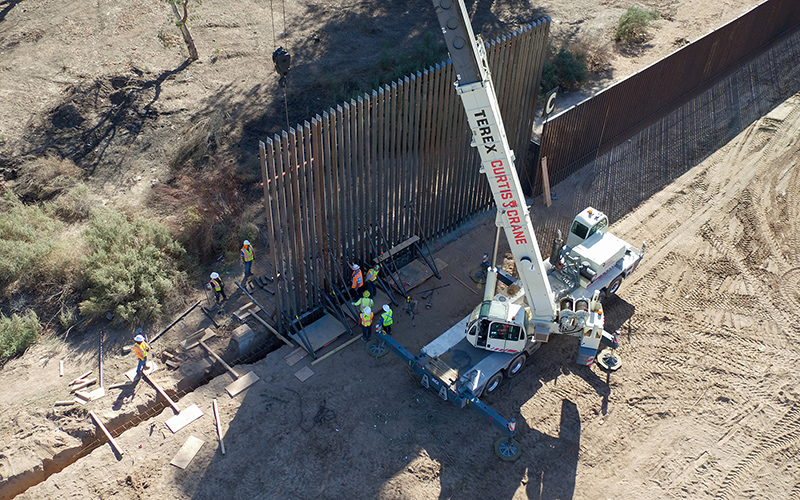
Workers repair a section of border wall near Calexico, California, in 2018. The Pentagon recently approved $1 billion for roads, lighting and 57 miles of border wall in the Yuma and El Paso sectors of the border. (Photo by Mani Albrecht/Customs and Border Protection)
WASHINGTON – President Donald Trump’s proposed border wall continued to inch forward this week, as the Democrat-controlled House failed Tuesday to block the border emergency declaration that let the Pentagon approve $1 billion in wall work Monday.
The Defense Department said it was tapping a counterdrug activities fund to let the Army Corps of Engineers begin planning on 57 miles of 18-foot-high pedestrian fencing, lighting and roads that the Department of Homeland Security has proposed in the Yuma and El Paso sectors of the border.
Critics said that circumventing Congress to take money from other Pentagon projects is not the right way to build a wall, but supporters said the wall is needed and that the Defense Department budget can take the hit.
“There’s always money to be found, when you’re looking at over $700 billion in the military (budget), there’s definitely $1 billion, if not $10 billion,” said Rep. Paul Gosar, R-Prescott. “I can probably point to $13 billion right off the top of my head.”
Gosar praised the president for taking action on the wall, calling it a “tenet that the president ran on and the people expect that.”
Movement on a wall was welcomed by Pinal County Sheriff Mark Lamb. He said a wall is a critical part of border security – but not the only part.
“The key words are ‘border security,’ and the wall is a piece of that,” Lamb said Tuesday.
“That entails also making sure our staffing levels are right for border patrol, making sure that we have the right technology,” he said. “I’d like to see more funding coming in to the local agencies to assist with trafficking of drugs.”
But Rep. Ruben Gallego, D-Phoenix, said the Trump administration is pursuing its goal of a border wall the wrong way.
After signing a DHS budget on Feb. 15 that included far less money than he wanted for a border wall, Trump declared a state of emergency at the border. The president said that declaration gives him legal authority to shift up to $6.6 billion from other agencies toward a wall, bringing total funding this year to about $8 billion.
“The question of where walls should be built or not built is not the substantive problem here,” Gallego said on the wall in Yuma. “If there’s a study that says this area should need it then it should go through the appropriate legislative process.
“Using an emergency declaration to do something that does not seem like an emergency and overriding the legislative process is the biggest problem of all,” he said.
Critics noted that Trump himself said he only declared the emergency because he wanted to fund a wall faster, and many in Congress worried about which military projects the Pentagon might tap. In Arizona alone, the Pentagon has identified $150 million in construction projects, with a $30 million project at Fort Huachuca identified as most vulnerable.
Within weeks, Congress voted to reject the emergency declaration, but Trump vetoed that resolution on March 15.
A House vote to override that veto fell short of the two-thirds majority needed Tuesday, with 14 Republicans joining 234 Democrats in the 248-181 vote. Arizona’s lawmakers voted along party lines on the measure, which needed 296 votes to succeed.
Gallego was disappointed, noting that some high-ranking officers have said that current military support for border security was already affecting troop readiness before the latest proposals.
“Any time we take money away that’s appropriated through the legislative process that’s supposed to go to the Armed Services Committee, by nature is going to eventually erode readiness.,” Gallego said.
Gosar said the president is well within his rights to find funding for the wall, which he sees as a commonsense solution.
“When we have a piece of property, we identify it with a fence,” he said. “You see people in Hollywood, people in California, people in Arizona and New York City do the same thing.”
Lamb agreed that a wall is necessary, but that it’s only one step on the fight against drug and human trafficking that border sheriffs face. He also hopes Congress passed “commonsense immigration reform to allow the path to come here and be part of the American Dream and make a better life for yourself.”
“If they can do that, that allows us to focus on drug trafficking and human trafficking,” Lamb said.
Follow us on Instagram.
